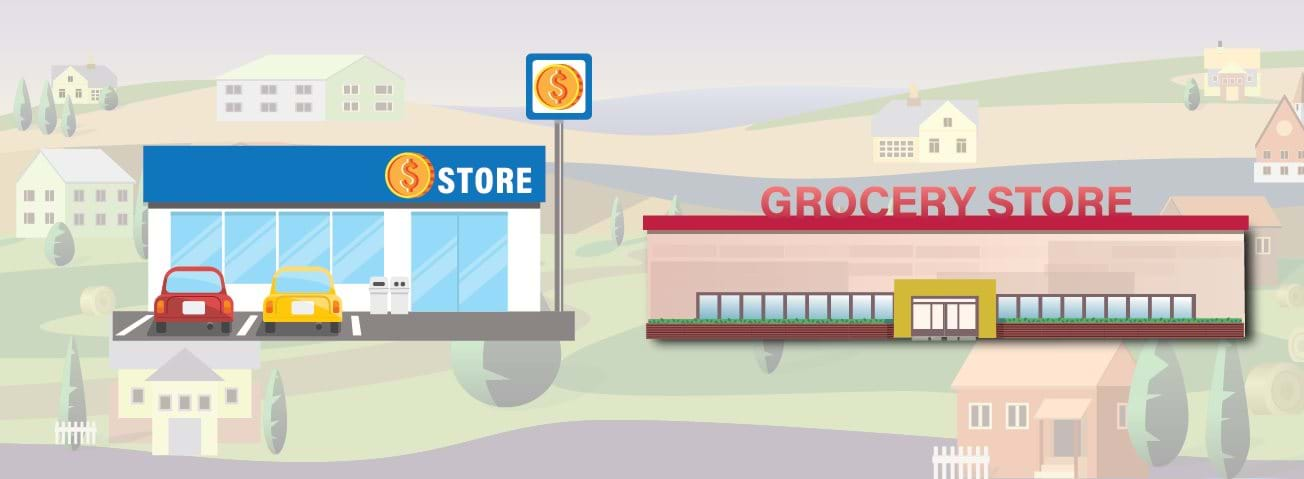Dollar Store Entry Affects Rural Grocery Stores More Than Urban

Independent grocery stores, or grocers whose owners operate fewer than four stores, have been a large part of the rural U.S. food retail landscape. In 2015, they represented about half of the food retailers in 44 percent of U.S. counties. Leading up to 2015, however, dollar stores were becoming increasingly visible in rural counties, experiencing the second-largest growth behind supercenters among food retailers from 1990 to 2015, according to research by USDA, Economic Research Service (ERS). Economists from ERS, North Dakota State University, and the University of Connecticut recently investigated the implications of the growth of dollar stores for more traditional, independent grocery stores using proprietary data from the National Establishment Time Series (NETS) database and the ERS Rural-Urban Commuting Area (RUCA) Codes.
NETS provides geographic, employment, and sales information for every year an establishment is open for all sectors of the U.S. economy. The researchers focused on dollar stores and independent grocery stores and combined these data with the ERS RUCA codes’ measures of population density, urbanization, and daily commuting to classify census tracts; in this research, all nonmetropolitan core or commuting areas were classified as rural.
The researchers examined what happened to the number of independent grocery stores, as well as employment and sales statistics from these stores, from 2000–19, when a new dollar store opened in the same rural or urban census tract. Results showed that when a dollar store opened in a census tract independent grocery retailers were 2.3 percent more likely, on average, to exit the market. Employment at independent grocery stores fell about 3.7 percent, and sales declined by 5.7 percent.
However, there was significant variation between the impact of dollar stores on independent grocery stores in urban and rural census tracts. For instance, the likelihood of an independent grocery store exiting a rural census tract after a new dollar store opened was 5 percent, about three times greater than in urban census tracts. Similarly, the decline in employment in rural tracts was about 2.5 times as large as in urban tracts, and the decline in sales was nearly double in rural census tracts.
In addition, the researchers found that in urban census tracts, these impacts waned after about 5 years following a dollar store’s entry, but the effects continued in rural census tracts. This could reduce grocery store options in rural areas for the longer term. Dollar stores generally have a more limited selection of food products, focusing more on prepacked and processed foods. If independent grocers are less likely to return to rural communities after dollar store entry, this could lead to a more limited selection of food products available in these areas and affect consumer access to healthy foods.
Dollar store expansion and independent grocery retailer contraction, by Lopez, R., Marchesi, K., and Steinbach, S., Applied Economic Perspectives and Policy, Agricultural and Applied Economics Association, 2023, https://doi.org/10.1002/aepp.13398 Available for open access through the USDA, National Agricultural Library.
The Food Retail Landscape Across Rural America, by Alexander Stevens, Clare Cho, Metin Cakir, Xiangwen Kong, and Michael A. Boland, ERS, June 2021
The Rural Food-Away-from-Home Landscape, 1990–2019, by Keenan Marchesi, Anne Byrne, and Trey Malone, ERS, March 2023
Nutritional Quality of Foods Acquired by Americans: Findings From USDA’s National Household Food Acquisition and Purchase Survey, by Lisa Mancino, Joanne Guthrie, Michele Ver Ploeg, and Biing-Hwan Lin, ERS, February 2018
Retailing & Wholesaling, by Anne Byrne and Eliana Zeballos , USDA, Economic Research Service, November 2023
Food Choices & Health, by Sabrina Young, USDA, Economic Research Service, March 2023
Food Access, by Alana Rhone, USDA, Economic Research Service, October 2022


